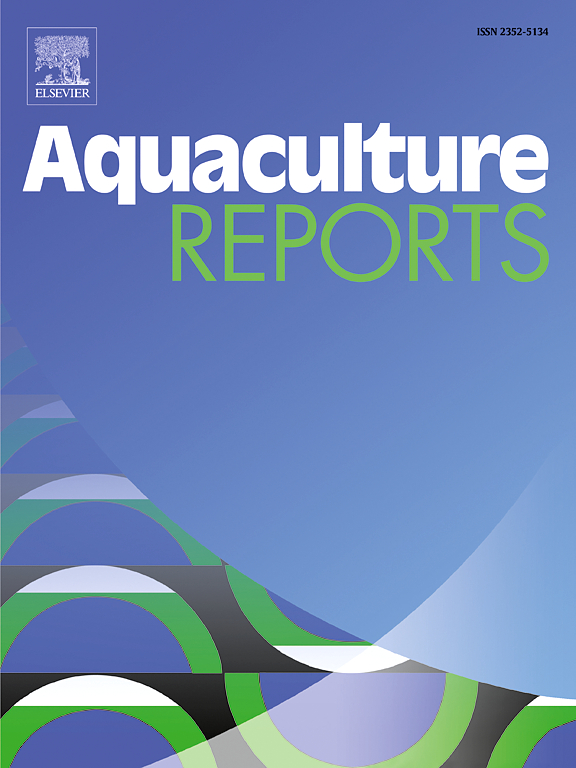豆油和棉籽油饲料对大口黑鲈生长、脂肪酸组成和鱼片品质的影响
IF 3.7
2区 农林科学
Q1 FISHERIES
引用次数: 0
摘要
一项双因素饲养试验评估了大豆油(SO)和棉籽油(CO)在50% %和100% %饲粮脂肪添加水平下对大口黑鲈(Micropterus salmoides)生长、脂肪代谢和鱼片品质的影响。将120尾鱼(51.66±0.01 g)分为SO50、CO50、SO100、CO100 4组。所有的饲料中含有30.2% %的鱼粉,约0.8 %的n-3长链多不饱和脂肪酸(n-3 LC-PUFA)。SO饲粮α-亚麻酸(ALA)水平高于CO。油源对生长性能有显著影响,CO,尤其是CO100,降低了末重、增重和特定生长率,提高了饲料系数(FCR)。补充CO显著降低了血浆甘油三酯(TG)、总胆固醇(TC)、低密度脂蛋白胆固醇(LDL-C)和肝脏TG,与此相应的是脂肪甘油三酯脂肪酶(atgl)表达和磷酸化amp活化蛋白激酶(p-AMPK)水平升高。鱼片质量参数也发生了变化,在CO饲料中,持水能力(WHC)降低,植物油含量为100% %时pH值升高,质地性能(黏结性、粘性和咀嚼性)改善。尽管SO组的ALA和去饱和酶基因表达量较高,但肌肉和肝脏中n-3 LC-PUFA含量以及肝脏脂肪酸去饱和酶(FADS)活性与CO组差异不显著。综上所述,CO中缺乏ALA,加上n-3 LC-PUFA转化能力有限,脂质分解代谢升高,尤其是CO100组,是大口黑鲈生长性能较差的原因。本文章由计算机程序翻译,如有差异,请以英文原文为准。
Growth, fatty acid composition, and fillet quality of largemouth bass (Micropterus salmoides) fed soybean oil and cottonseed oil diets
A two-factor feeding trial evaluated the effects of soybean oil (SO) and cottonseed oil (CO), at 50 % or 100 % dietary lipid inclusion on growth, lipid metabolism, and fillet quality in largemouth bass (Micropterus salmoides). A total of 120 fish (51.66 ± 0.01 g) were assigned to four groups: SO50, CO50, SO100, CO100. All diets contained 30.2 % fishmeal, with approximately 0.8 % n-3 long-chain polyunsaturated fatty acids (n-3 LC-PUFA). SO diets had higher α-linolenic acid (ALA) level than CO. Growth performance was significantly affected by oil sources, with CO, particularly CO100, causing reduced final body weight (FBW), weight gain (WG) and specific growth rate (SGR), and higher feed conversation ratio (FCR). CO supplementation significantly reduced plasma triglycerides (TG), total cholesterol (TC) and low-density lipoprotein cholesterol (LDL-C) and hepatic TG, corresponding with elevated adipose triglyceride lipase (atgl) expression and phosphorylated AMP-activated protein kinase (p-AMPK) levels. Fillet quality parameters also changed, with decreased water holding capacity (WHC), increased pH at 100 % vegetable oil inclusion, and improved textural properties (cohesiveness, gumminess, and chewiness) in CO diets. Although dietary ALA and desaturase gene expressions were higher in the SO groups, the n-3 LC-PUFA content in muscle and liver, as well as hepatic fatty acid desaturase (FADS) activities, did not differ significantly from those in the CO groups. In conclusion, the lack of ALA in CO, combined with limited n-3 LC-PUFA conversion capacity and the elevated lipid catabolism, particularly in the CO100 group, contributed to the inferior growth performance in largemouth bass.
求助全文
通过发布文献求助,成功后即可免费获取论文全文。
去求助
来源期刊

Aquaculture Reports
Agricultural and Biological Sciences-Animal Science and Zoology
CiteScore
5.90
自引率
8.10%
发文量
469
审稿时长
77 days
期刊介绍:
Aquaculture Reports will publish original research papers and reviews documenting outstanding science with a regional context and focus, answering the need for high quality information on novel species, systems and regions in emerging areas of aquaculture research and development, such as integrated multi-trophic aquaculture, urban aquaculture, ornamental, unfed aquaculture, offshore aquaculture and others. Papers having industry research as priority and encompassing product development research or current industry practice are encouraged.
 求助内容:
求助内容: 应助结果提醒方式:
应助结果提醒方式:


